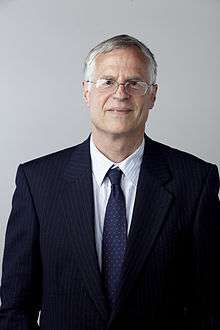Timothy Holland
Timothy John Barrington Holland FRS is a petrologist and reader in the Department of Earth Sciences at the University of Cambridge.[3]
Tim Holland | |
|---|---|
 Timothy Holland at the Royal Society admissions day in London, July 2014 | |
| Born | Timothy John Barrington Holland |
| Alma mater | University of Oxford (DPhil) |
| Awards | The Murchison Fund (1995) |
| Scientific career | |
| Fields | Petrology |
| Institutions | University of Cambridge |
| Thesis | Structural and Metamorphic Studies of Eclogites and Associated Rocks in the Central Tauern Region of the Eastern Alps (1977) |
| Doctoral advisor | Stephen W. Richardson[1][2] |
| Website | esc |
Education
Holland was educated at the University of Oxford where he was awarded a Doctor of Philosophy degree in 1977[1] for research on eclogites in the tauern region of the Alps supervised by Stephen W. Richardson.[2]
Research and career
Holland's research investigates the computation of petrological phase equilibria.[2][4][5][6][7][8][9][10] His research has been funded by the Natural Environment Research Council (NERC).[11]
Holland has made fundamental and enduring contributions to petrology.[12] He was the first to show that surface rocks had been buried to over 70 km.[12] He has worked to construct a self-consistent thermodynamic database which describes equilibria among the multi-component mineral phases important in rocks and with full propagation of errors.[12] This work, among the most highly cited in the geosciences, now underpins most petrological research.[12] Recent advances include the calculation of mineral assemblages and compositions as a function of composition, pressure and temperature and the thermodynamic modelling of silicate melts, critical to tectonic interpretations of deeply buried rocks.[12]
Awards and honours
Holland was elected a Fellow of the Royal Society (FRS) in 2014[12] for “substantial contribution to the improvement of natural knowledge”.[13] He was awarded The Murchison Fund by the Geological Society of London in 1995.
References
- Holland, Timothy John Barrington (1977). Structural and metamorphic evolution of eclogites and associated rocks in the central Tauern region of the eastern Alps. jisc.ac.uk (DPhil thesis). University of Oxford. OCLC 321017954. EThOS uk.bl.ethos.459466.
- Holland, T. J. B.; Richardson, S. W. (1979). "Amphibole zonation in metabasites as a guide to the evolution of metamorphic conditions". Contributions to Mineralogy and Petrology. 70 (2): 143. doi:10.1007/BF00374442.
- Timothy Holland publications indexed by the Scopus bibliographic database. (subscription required)
- "Dr Tim Holland, Department of Earth Sciences". University of Cambridge. Archived from the original on 18 May 2009.
- Blundy, J. D.; Holland, T. J. B. (1990). "Calcic amphibole equilibria and a new amphibole-plagioclase geothermometer". Contributions to Mineralogy and Petrology. 104 (2): 208. doi:10.1007/BF00306444.
- Holland, T. J. B.; Powell, R. (2004). "An internally consistent thermodynamic data set for phases of petrological interest". Journal of Metamorphic Geology. 16 (3): 309. doi:10.1111/j.1525-1314.1998.00140.x.
- Holland, T. J. B.; Powell, R. (1990). "An enlarged and updated internally consistent thermodynamic dataset with uncertainties and correlations: The system K₂–Na₂O–CaO–MgO–MnO–FeO–Fe₂O₃–Al₂O₃–TiO₂–SiO₂–C–H₂–O₂". Journal of Metamorphic Geology. 8: 89. doi:10.1111/j.1525-1314.1990.tb00458.x.
- Powell, R.; Holland, T. J. B. (1988). "An internally consistent dataset with uncertainties and correlations: 3. Applications to geobarometry, worked examples and a computer program". Journal of Metamorphic Geology. 6 (2): 173. doi:10.1111/j.1525-1314.1988.tb00415.x.
- Holland, T.; Blundy, J. (1994). "Non-ideal interactions in calcic amphiboles and their bearing on amphibole-plagioclase thermometry". Contributions to Mineralogy and Petrology. 116 (4): 433. doi:10.1007/BF00310910.
- Holland, T. J. B. (1990). "Activities of components in omphacitic solid solutions". Contributions to Mineralogy and Petrology. 105 (4): 446. doi:10.1007/BF00286831.
- UK Government research grants awarded to Timothy Holland via Research Councils UK
- Anon (2014). "Dr Timothy Holland FRS". royalsociety.org. London: Royal Society. Archived from the original on 2 May 2014. One or more of the preceding sentences incorporates text from the royalsociety.org website where:
“All text published under the heading 'Biography' on Fellow profile pages is available under Creative Commons Attribution 4.0 International License.” --Royal Society Terms, conditions and policies at the Wayback Machine (archived 2016-11-11)
- Anon (2015). "Royal Society Elections". London: Royal Society. Archived from the original on 6 September 2015.
![]()